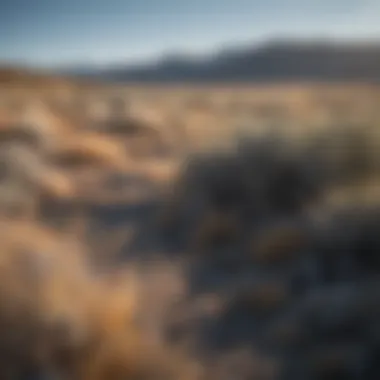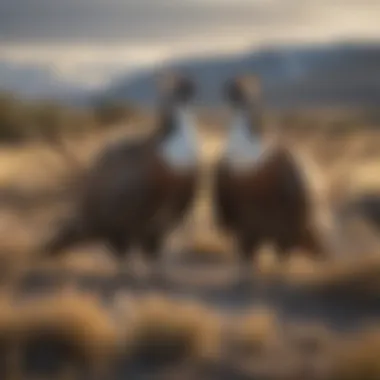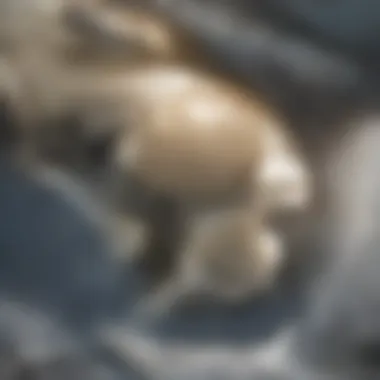Sage Grouse Conservation: A Comprehensive Examination


Intro
The sage grouse is a remarkable bird that plays a critical role in maintaining the ecological balance of its habitat. This species thrives in the sagebrush ecosystems found primarily in the western United States. However, the numbers of sage grouse have been in decline due to various factors, predominantly habitat loss. Understanding the complex elements surrounding sage grouse conservation is essential. This involves examining the ecological importance of the species, the contemporary challenges it faces, and the multi-faceted efforts aimed at its preservation.
This examination also navigates through the legislative measures and collaborative initiatives currently underway, providing clarity on how different stakeholders are contributing to the conservation landscape. From policymakers to environmental organizations, understanding these roles is vital for the effective safeguarding of the sage grouse and its habitat.
The following sections aim to provide a comprehensive walk-through of conservation dynamics, thus creating a deeper awareness of the critical issues surrounding sage grouse populations. A focused analysis of conservation strategies, research gaps, and future directions will further enrich this discussion.
Prelude to Sage Grouse Conservation
The conservation of sage grouse is a topic that resonates with various stakeholders, including researchers, policymakers, and environmental enthusiasts. This bird symbolizes the health of sagebrush ecosystems, crucial habitats that support a wealth of biodiversity. Understanding the need for sage grouse conservation not only highlights the species itself but also the larger ecological framework in which it operates. This section dives deep into why focusing on sage grouse is essential.
Sage grouse, often seen as a keystone species, play a vital role in their ecosystem. Their presence or absence considerably affects other organisms within sagebrush habitats. Recognizing their importance leads to a greater understanding of the broader implications of these ecosystems on wildlife health, climate regulation, and overall ecological integrity.
In addition to ecological considerations, sage grouse conservation carries significant socio-economic implications. Local economies rely on sustainable land use practices, which are closely linked to the health of sagebrush ecosystems. By ensuring sage grouse populations thrive, we help maintain a balanced relationship between environmental health and economic vitality.
Given these reasons, the study of sage grouse conservation becomes imperative. Through comprehensive examination, we uncover various threats they face, the legislative frameworks that guide conservation efforts, and successful strategies that can be implemented. This narrative will serve as a crucial resource for those engaged in the fight to protect not just the sage grouse, but the entire ecosystem they represent.
Overview of the Sage Grouse Species
The sage grouse, known scientifically as Centrocercus urophasianus, is a large bird native to the western United States and parts of Canada. This species is distinctive for its elaborate courtship displays and unique habitat preferences. They are often found in open, arid areas with dense sagebrush cover, which provides essential food and nesting sites. The male sage grouse is particularly notable during the breeding season when he performs intricate displays to attract females, showcasing the importance of social behavior in their reproduction.
Habitat specialization makes sage grouse vulnerable to environmental changes. As grasslands and shrublands face pressures from urban development, agriculture, and energy extraction, sage grouse populations decline. Understanding their specific habitat requirements is crucial for any conservation strategy targeting this species.
Ecological Role of Sage Grouse
Sage grouse have a unique position in their ecosystems, often referred to as a benevolent indicator species. Their presence supports a wide range of other wildlife, including mammals, reptiles, and various bird species that rely on sagebrush habitats for survival. The decline of sage grouse can signal broader ecological issues affecting these environments.
Furthermore, the sage grouse contributes to seed dispersal, helping maintain plant diversity within its habitat. They are particularly in tune with the cyclical nature of their environment, needing certain plant species to thrive at different times of the year. By protecting sage grouse and their habitats, we also protect the intricate web of life that depends on these ecosystems.
"The health of sage grouse populations is a bellwether for the ecological vitality of the greater sagebrush biome."
As experts and advocates work towards conservation, understanding these dynamics is key to crafting effective strategies. Thus, this comprehensive analysis of sage grouse conservation looks at the multifaceted roles they play within their ecosystems, the challenges they face, and the necessary actions needed to secure their future.
Threats to Sage Grouse Populations
Understanding the threats to sage grouse populations is crucial for the effective conservation of this species. Numerous factors contribute to the decline of sage grouse, and recognizing these elements is a key step for stakeholders involved in conservation efforts. Each threat has its own set of complexities and implications, which underscores the necessity for targeted strategies and collaborative efforts to address them. This section explores the primary threats: habitat loss and fragmentation, the impact of energy development, grazing practices, and climate change considerations.
Habitat Loss and Fragmentation
The most significant threat to sage grouse populations is habitat loss and fragmentation. The sagebrush ecosystem, which is essential for the survival of sage grouse, has been reduced due to various human activities, including urban development, agriculture, and infrastructure expansion. These pressures cause the sagebrush habitat to become fragmented, isolating sage grouse populations and preventing them from accessing essential resources such as food and breeding sites.
Sage grouse depend heavily on intact sagebrush habitats for nesting and brood-rearing. When these habitats are destroyed or fragmented, the birds face increased risks such as predation and difficulties finding mates. Moreover, habitat loss can lead to decreased genetic diversity, which is critical for the long-term resilience of any species. Studies indicate that the connectivity of habitats is vital for maintaining sage grouse populations; therefore, conserving large, continuous tracts of sagebrush is necessary for their survival.
Impact of Energy Development
Energy development poses a substantial threat to sage grouse populations. The extraction of oil and gas, as well as wind farm installations, often occurs within sage grouse habitats. The infrastructure associated with these developments, such as roads and drilling sites, not only physically alters the environment but also introduces disturbances that can displace sage grouse from their traditional habitats.
Moreover, increased human presence and noise can interfere with the birds' courtship displays, which are vital for breeding. Research indicates that sage grouse avoid areas close to energy developments, leading to reduced populations in proximate regions. Therefore, careful consideration of energy development projects is necessary to mitigate their impacts on sage grouse and their habitats.


Grazing Practices and Their Effects
Grazing practices can also significantly affect sage grouse populations. Livestock grazing can lead to habitat degradation and the introduction of invasive species that compete with native vegetation. Overgrazing can reduce the availability of essential forage for sage grouse, ultimately impacting their survival. Furthermore, intense grazing pressure can increase soil erosion and damage habitat structure, making it unsuitable for nesting and rearing young.
Effective management of grazing practices is essential. This includes rotating grazing areas or using alternatives such as prescribed burns to maintain healthy sagebrush ecosystems. Implementing sustainable grazing practices can contribute to the recovery and stability of sage grouse populations.
Climate Change Considerations
Climate change presents a long-term threat to sage grouse populations by altering their habitats and food sources. Changes in precipitation patterns, temperature extremes, and increased frequency of wildfires can disrupt sagebrush ecosystems. As climate conditions shift, they may also lead to the invasion of non-native species that outcompete native sagebrush and its associated fauna.
The resilience of sage grouse to climate changes will depend on the health of their remaining habitats and the adaptability of their populations. Conservation efforts must account for potential climate impacts and incorporate strategies to enhance ecosystem resilience.
"To effectively conservation sage grouse, it is essential to focus on the habitat and address the multiple threats it faces."
In summary, each of these threats to sage grouse populations is significant and interconnected. By recognizing and addressing them, conservationists and stakeholders can make informed decisions to better protect one of North America's most imperiled bird species.
Legal Frameworks for Sage Grouse Conservation
The legal frameworks in place for sage grouse conservation play a critical role in safeguarding the species and its habitat. These frameworks outline various regulations and policies that dictate the actions of both governmental and non-governmental entities. Without such guidelines, efforts to maintain and restore sage grouse populations may lack coordination and effectiveness. Thus, understanding these legal aspects is essential for anyone involved in conservation work or research.
Endangered Species Act Implications
The Endangered Species Act (ESA) is a significant piece of legislation in the United States, designed to protect endangered and threatened species. Sage grouse, due to habitat loss and declining numbers, has come under consideration for protection under this act. The implications of the ESA for sage grouse are profound. It provides legal protection against actions that could jeopardize the existence of the species or destroy its habitat.
However, the potential listing of sage grouse as endangered sparks concerns among landowners and industries such as agriculture and energy extraction. When a species is listed, development activities may be subject to stringent reviews and restrictions.
Key points regarding ESA for sage grouse include:
- Protection Measures: Listing under the ESA mandates federal agencies to develop recovery plans focused on habitat conservation and restoration.
- Stakeholder Impact: The ESA also influences stakeholders by changing land use practices and imposing additional regulatory burdens on development projects.
- Funding Opportunities: Protection under the ESA may unlock funding aimed at conservation initiatives, benefiting both sage grouse and their habitats.
"Understanding the implications of the Endangered Species Act is critical for effective sage grouse conservation, as it shapes the regulatory landscape that governs habitat protection efforts."
State and Federal Policy Interactions
The interaction between state and federal policies is crucial in the realm of sage grouse conservation. Each state has its management strategies, yet these often must align with federal regulations. Such interactions can lead to both positive collaborations and, at times, conflicts.
States with significant sage grouse populations have implemented their plans to manage the species in line with local conditions and stakeholder interests. Simultaneously, federal policies aim to establish broader conservation measures that affect multiple states across the Western United States.
Important aspects of state and federal policy interactions include:
- Collaborative Management: State and federal agencies often work together to create Integrated Resource Management Plans, which help coordinate conservation efforts.
- Discrepancies in Regulations: Differences in state laws can lead to confusion and inconsistent conservation efforts, making it challenging to devise unified strategies.
- Economic Considerations: The economic interests of states can significantly influence policy formation, impacting the level of protection afforded to sage grouse populations.
Understanding these legal frameworks and their implications is vital for fostering effective conservation strategies. Knowledge of both state and federal policies will enable stakeholders to navigate the regulatory landscape efficiently and contribute to the preservation of the sage grouse.
Conservation Strategies and Measures
Conservation strategies and measures are crucial for safeguarding the sage grouse populations and their habitat. This section discusses the importance of various approaches that enhance conservation efforts. By understanding specific strategies, stakeholders can work more effectively toward the common goal of preserving this species. Successful conservation is built on collaboration, restoration, and adaptation to changing circumstances.
Collaborative Conservation Efforts
Public-Private Partnerships


Public-private partnerships are becoming increasingly vital in conserving the sage grouse. These collaborations blend the resources and expertise of government entities with those of private organizations. This approach fosters a more comprehensive and efficient conservation strategy.
The key characteristic of public-private partnerships is the shared responsibility among stakeholders. These partnerships often lead to innovative solutions that take into account both ecological requirements and economic realities. For sage grouse conservation, such collaborations can facilitate habitat acquisition, provide funding for restoration projects, and promote sustainable land-use practices.
A unique feature of public-private partnerships is their flexibility. They can be tailored to meet specific regional needs, allowing for localized conservation efforts. This adaptability is a significant advantage, though finding common goals among diverse interests can also present challenges.
Stakeholder Engagement
Stakeholder engagement is essential for effective sage grouse conservation. Engaging all parties, including landowners, government agencies, and environmental groups, fosters a more inclusive approach to conservation.
The key characteristic of stakeholder engagement is that it encourages participatory decision-making. This approach ensures that the voices of all relevant parties are heard and considered, making the conservation efforts more robust.
One unique feature of stakeholder engagement is its ability to build trust and transparency among parties involved. This trust leads to more successful collaboration. However, the process can be time-consuming, and differing priorities may arise, which can complicate efforts. Nevertheless, focusing on communication can lead to successful outcomes.
Habitat Restoration Techniques
Habitat restoration techniques are critical in reversing the negative impacts that have affected sage grouse populations. Various methods are used to restore natural habitats, promoting the conditions necessary for the sage grouse to thrive. Techniques may include re-seeding native plants, controlling invasive species, and restoring water sources. Each method plays a significant role in creating a sustainable environment for the sage grouse.
Restoration efforts focus on improving vegetation structure and cover, as these are vital for the biological needs of sage grouse. Monitoring success is crucial, and adaptive approaches allow for ongoing improvements to restoration efforts.
Adaptive Management Practices
Adaptive management practices are necessary for continuously improving conservation efforts. This process involves monitoring ecosystems and adjusting management strategies based on observed changes and outcomes.
Key to adaptive management is the idea of learning from experience. By collecting data and analyzing results, conservation practitioners can identify what works and what doesn’t, making informed decisions for future actions.
A unique aspect of adaptive management is its iterative nature. This enables management strategies to evolve based on real-time data and changing environmental conditions. This flexibility enhances the resilience of sage grouse populations against various threats.
Research Initiatives and Findings
Research initiatives play a crucial role in the conservation of sage grouse. They provide insights into the species' behavior, habitat needs, and responses to environmental changes. Understanding these elements is vital for formulating effective conservation strategies. As various threats impact sage grouse populations, systematic research becomes more important for real-time data and long-term planning.
Scientific studies help to inform policymakers and conservationists about the best practices to protect this species. With thorough research, stakeholders can analyze the effectiveness of existing strategies and adapt to new challenges as they arise.
Current Scientific Studies
Numerous scientific studies highlight different aspects of sage grouse biology and ecology. For instance, research focuses on breeding habits, habitat suitability, and population dynamics. These studies often involve both fieldwork and modeling approaches.
A prominent area of research includes the examination of habitat preferences during different seasons. Studies such as those conducted by the U.S. Geological Survey delve into how variations in vegetation affect sage grouse nesting success. Other research projects explore the genetic diversity within populations, which is essential for understanding resilience against diseases and environmental shifts.
"Understanding habitat utilization is essential for effective sage grouse conservation, as it shapes management strategies that can enhance population stability."
Monitoring and Data Collection
Monitoring and data collection are vital components of sage grouse conservation efforts. These activities provide essential information about population trends, distribution, and habitat changes over time. Regular monitoring allows for the timely identification of potential threats, enabling proactive management interventions.
One method used for monitoring involves aerial surveys to estimate populations and assess habitat conditions. This technique helps to cover large areas and gather data quickly. Additionally, researchers also utilize technology such as GPS collars to track individual birds and their movement patterns. This data can reveal how sage grouse interact with their environment and respond to disturbances.
The integration of citizen science also plays a role in data collection. Engaging local communities in monitoring efforts increases data richness while fostering public awareness and involvement in conservation efforts. Through such collaborative approaches, the long-term viability of sage grouse populations can be more effectively ensured.


Case Studies in Sage Grouse Conservation
Examining case studies in sage grouse conservation is vital for understanding what strategies work in different contexts. These real-world examples provide insights into the successes and challenges faced by conservationists. Understanding these case studies allows researchers, policymakers, and stakeholders to learn from past experiences, both positive and negative. Through analyzing specific initiatives, the community gains knowledge that can be applied to enhance future conservation efforts. These case studies also demonstrate the importance of collaboration among various groups in the conservation field.
Successful State-Level Initiatives
State-level initiatives play a crucial role in sage grouse conservation. They often reflect unique state-specific challenges and solutions, tailoring approaches that align with local needs. For instance, in Colorado, the state has implemented a proactive approach known as the Sage Grouse Habitat Exchange program. This involves landowners receiving credits for voluntarily improving sage grouse habitats on their properties, promoting better land use practices.
Moreover, Nevada has been noted for its statewide conservation plan, which integrates multiple agencies and stakeholders. This plan emphasizes data-driven decision-making, creating a framework for habitat restoration, grazing management, and monitoring of sage grouse populations. The success here lies in the collaboration and clear communication between all involved parties.
"Successful state-level initiatives often serve as models for other regions, demonstrating the potential for localized solutions in broader conservation efforts."
Comparative Analysis of Different Regions
The varying approaches taken in different regions provide a fertile ground for comparative analysis. In Utah, for example, conservation efforts focus heavily on scientific research and leveraging technological tools for monitoring sage grouse populations. This focus leads to innovative methods for assessing habitat quality and identifying areas needing restoration.
Conversely, Montana has prioritized community engagement through its Local Conservation Planning framework. This approach allows communities to play an active role in developing conservation plans that address their specific needs while ensuring the well-being of sage grouse populations.
In sum, understanding how different regions tackle sage grouse conservation illuminates the diverse pathways available to enhance efforts. Highlighting the successes, conflicts, and adaptive strategies allows for a deeper comprehension of conservation's complexities and nuances. The balance between ecological needs and community interests is a common theme across these case studies.
Future Directions in Sage Grouse Conservation
The future directions of sage grouse conservation represent a critical juncture for the survival of this species. Given the complex interplay of ecological, economic, and social factors, it is essential to identify pathways that will lead to sustainable conservation practices. This section emphasizes emerging challenges and opportunities, as well as the role of technology in enhancing conservation efforts.
Emerging Challenges and Opportunities
As we look ahead, emerging challenges pose significant risks to sage grouse populations. These may stem from ongoing habitat loss, climate change impacts, and evolving land-use pressures. For instance, changes in agricultural practices can alter the landscape where sage grouse thrive. Furthermore, the continuing development of energy resources can exacerbate habitat fragmentation, reducing connectivity between populations.
However, there are also opportunities that can be leveraged. Collaborative approaches involving various stakeholders, including government agencies, conservation organizations, and landowners, can create more effective management strategies. Engaging the local communities in the decision-making process fosters stewardship and enhances long-term commitment to conservation objectives. The integration of conservation easements and incentive programs can motivate landowners to preserve sage grouse habitats.
"Future success in sage grouse conservation relies on understanding and addressing the complexities of human-environment interactions."
Role of Technology in Conservation Efforts
Technology plays a pivotal role in shaping the future of sage grouse conservation. Recent advancements in data collection and monitoring techniques enable researchers to gain deeper insights into population dynamics and habitat use. Tools such as GPS tracking and remote sensing provide critical information on migration patterns, breeding sites, and habitat selection.
Moreover, machine learning algorithms can analyze vast amounts of ecological data, identifying trends and predicting future population viability. This predictive modeling is invaluable for proactive conservation planning, allowing for timely interventions based on projected outcomes.
Finally, the use of technology also extends to public engagement. Interactive platforms, such as social media and community apps, help disseminate vital information to the public, raising awareness about sage grouse issues. These technologies foster a collective sense of responsibility and empower individuals to contribute to conservation efforts.
End: The Path Forward
As we reflect on the intricate issues surrounding sage grouse conservation, it becomes evident that the path forward requires a multifaceted approach. The discussions throughout this article have highlighted the paramount importance of addressing the ecological needs of sage grouse while balancing economic development and conservation goals. The threats these birds face—from habitat loss to climate change—demand immediate and ongoing attention from all stakeholders involved.
Synthesis of Key Findings
In synthesizing the information presented, several key findings emerge:
- Critical Habitat Needs: The availability of connected and healthy sagebrush habitats is essential for the survival of sage grouse. Protecting these habitats should be a priority, as their degradation poses significant risks to the species.
- Stakeholder Engagement: Involving local communities, government agencies, and private landowners in conservation strategies has proven effective. Collaborative efforts often lead to more sustainable practices and better outcomes for all involved.
- Adaptive Management: The need for adaptive management practices is clear. As new challenges arise—such as shifting climate patterns—management strategies must also evolve. This flexibility is key to making informed decisions that benefit both sage grouse and local ecosystems.
"The resilience of sage grouse populations is closely linked to the efficacy of collaborative conservation efforts, making stakeholder partnership critical for success."
Call to Action for Stakeholders
For stakeholders, the call to action is urgent:
- Support Local Initiatives: Stakeholders are encouraged to actively support or participate in community conservation programs. Local initiatives often provide a strong foundation for broader conservation efforts.
- Advocate for Policy Change: Engaging with policymakers to advocate for stronger protections under legal frameworks, such as the Endangered Species Act, can help bolster conservation measures.
- Embrace Research Collaboration: Collaboration with universities and research institutions can enhance our understanding of sage grouse biology, habitat use, and the impacts of management strategies.



